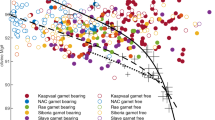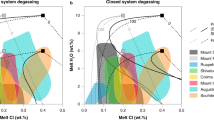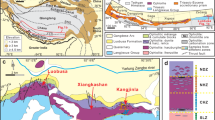Abstract
Recent seismological, geochemical and experimental observations suggest that, as mantle peridotite melts, the resulting basaltic liquid forms an interconnected network, culminating in the rapid ascent of the basalt relative to the surrounding solid matrix1,2,3. Mantle melting is therefore a polybaric process, with melts produced over a range of pressures having differing chemical characteristics4,5,6. Modelling and peridotite-melting experiments designed to simulate polybaric mantle melting generally assume that there is no interaction between melts generated at greater pressures and the overlying solid mantle at lower pressures5,7. Beneath mid-ocean ridges, melts derived from greater depth are probably channelized during ascent, so preventing direct re-equilibration with shallow peridotite8, as required by geochemical observations6,9. I show here, however, that sodium in ascending melts will quickly diffuse into the melt formed within nearby peridotite at lower pressures. This process fundamentally changes the manner by which the peridotite melts, and can account for both the creation of silica-rich glass inclusions in mantle xenoliths and the anomalous melting modes recorded by abyssal peridotites. Increased melting of lithosphere and upwelling asthenosphere could result from this process without the need to invoke higher mantle temperatures.
This is a preview of subscription content, access via your institution
Access options
Subscribe to this journal
Receive 51 print issues and online access
$199.00 per year
only $3.90 per issue
Buy this article
- Purchase on Springer Link
- Instant access to full article PDF
Prices may be subject to local taxes which are calculated during checkout



Similar content being viewed by others

References
Toomey, D. R., Wilcock, W. S. D., Solomon, S. C., Hammond, W. C. & Orcutt, J. A. Mantle seismic structure beneath the MELT region of the East Pacific Rise from P and S wave tomography. Science 280, 1224–1227 ( 1998).
McKenzie, D. The generation and compaction of partially molten rock. J. Petrol. 25, 713–765 (1984).
Waff, H. S. & Bulau, J. R. Equilibrium fluid distribution in an ultramafic partial melt under hydrostatic stress conditions. J. Geophys. Res. 84, 6109–6114 (1979).
Klein, E. & Langmuir, C. H. Global correlations of ocean ridge basalt chemistry with axial depth and crustal thickness. J. Geophys. Res. 92, 8089–8115 (1987).
Kinzler, R. J. & Grove, T. Primary magmas of mid-ocean ridge basalts; 2, Applications. J. Geophys. Res. 97, 6907 –6926 (1992).
Johnson, K. T. M., Dick, H. J. B. & Shimizu, N. Melting in the oceanic upper mantle: an ion microprobe study of diopsides in abyssal peridotites. J. Geophys. Res. 95, 2661–2678 (1990).
Hirose, K. & Kushiro, I. The effect of melt segregation on polybaric mantle melting: Estimation from the incremental melting experiments. Phys. Earth Planet. Inter. 107, 111– 118 (1998).
Kelemen, P. B., Shimizu, N. & Salters, V. J. M. Extraction of mid-ocean-ridge basalt from the upwelling mantle by focused flow of melt in dunite channels. Nature 375, 747–753 ( 1995).
Kelemen, P. B., Hirth, G., Shimizu, N., Spiegelman, M. & Dick, H. J. B. Review of melt migration processes in the adiabatically upwelling mantle beneath oceanic spreading ridges. Phil. Trans. R. Soc. Lond. 355, 283–318 (1997).
Stolper, E. M. A phase diagram for mid-ocean ridge basalts: Preliminary results and implications for petrogenesis. Contrib. Mineral. Petrol. 74, 13–27 (1980).
Hirose, K. & Kushiro, I. Partial melting of dry peridotites at high pressures; determination of compositions of melts segregated from peridotite using aggregates of diamond. Earth Planet. Sci. Lett. 114, 477–489 ( 1993).
Takahashi, E. Melting of a dry peridotite KLB-1 up to 14 GPa: implication on the origin of peridotitic upper mantle. J. Geophys. Res. 91, 9367–9382 (1986).
Lundstrom, C. C., Gill, J. & Williams, Q. A geochemically consistent hypothesis for MORB generation. Chem. Geol. 162, 105–126 (2000).
Watson, E. B. Basalt contamination by continental crust: some experiments and models. Contrib. Mineral. Petrol. 80, 73–87 (1982).
Watson, E. B. & Jurewicz, S. R. Behavior of alkalies during diffusive interaction of granitic xenoliths with basaltic magma. J. Geol . 92, 121–131 ( 1984).
Lesher, C. E. Kinetics of Sr and Nd exchange in silicate liquids—theory, experiments, and applications to uphill diffusion, isotopic equilibration, and irreversible mixing of magmas. J. Geophys. Res. 99, 9585 –9604 (1994).
Kushiro, I. On the nature of silicate melt and its significance in magma genesis: regularities in the shift of the liquidus boundaries involving olivine, pyroxene and silica minerals. Am. J. Sci. 275, 411– 431 (1975).
Ryerson, F. J. Oxide solution mechanisms in silicate melts—systematic variations in the activity coefficient of silica. Geochim. Cosmochim. Acta 49, 637–649 (1985).
Hirschmann, M. M., Baker, M. B. & Stolper, E. M. The effect of alkalies on the silica content of mantle-derived melts. Geochim. Cosmochim. Acta. 62, 883 –902 (1998).
Walter, M. J. & Presnall, D. C. Melting behavior of simplified lherzolite in the system CaO-MgO-Al2O3-SiO2-Na 2O from 7 to 35 kbar. J. Petrol. 35, 329–359 (1994).
Baker, M. B., Hirschmann, M. M., Ghiorso, M. S. & Stolper, E. M. Compositions of near-solidus peridotite melts from experiments and thermodynamic calculation. Nature 375, 308– 311 (1995).
Robinson, J. A. C., Wood, B. J., & Blundy, J. D. The beginning of melting of fertile and depleted peridotite at 1.5 GPa. Earth Planet. Sci. Lett. 155 , 97–111 (1998).
Frey, F. A. & Green, D. H. The mineralogy, geochemistry, and origin of lherzolite inclusions in Victorian basanites. Geochim. Cosmochim. Acta 38, 1023–1059 (1974).
Vannucci, R., Botazzi, P., Wulf-Pedersen, E. & Neumann, E. R. Partitioning of REE, Y, Sr, Zr and Ti between clinopyroxene and silicate melts in the mantle under La Palma (Canary Islands): implications for the nature of the metasomatic agents. Earth Planet. Sci. Lett. 158, 39–51 (1998).
Shaw, C. S. J., Thibault, Y., Edgar, A. D. & Lloyd, F. E. Mechanisms of orthopyroxene dissolution in silica-undersaturated melts at 1 atmosphere and implications for the origin of silica-rich glass in mantle xenoliths. Contrib. Mineral. Petrol. 132, 354– 370 (1998).
Draper, D. S. & Green, T. H. P–T phase relations of silicic, alkaline, aluminous mantle-xenolith glasses under anhydrous and C-O-H fluid-saturated conditions. J. Petrol. 38, 1187–1224 (1997).
Dick, H. J. B., Fisher, R. L. & Bryan, W. B. Mineralogic variability of the uppermost mantle along mid-ocean ridges. Earth Planet. Sci. Lett. 69, 88–106 (1984).
Niu, Y., Langmuir, C. H. & Kinzler, R. J. The origin of abyssal peridotites: a new perspective. Earth Planet. Sci. Lett. 152, 251– 265 (1997).
Elthon, D. Chemical trends in abyssal peridotites; refertilization of depleted suboceanic mantle. J. Geophys. Res. 97, 9015– 9025 (1992).
Langmuir, C. H. & Hanson, G. An evaluation of major element heterogeneity in the mantle sources of basalts. Phil. Trans. R. Soc. Lond. A 297, 383– 407 (1980).
Acknowledgements
I thank P. Kelemen and P. Asimow for comments on the manuscript, and P. Hess, D. Forsyth, Y. Liang, Q. Williams and M. Rutherford for suggestions. I also thank M. Rutherford for use of his laboratory, J. Devine and M. Jercinovic for assistance with the electron microprobes, and K. Hoernle, E. Takahashi and M. Perfit for sample donation. This work was supported by an SGER grant from the NSF.
Author information
Authors and Affiliations
Rights and permissions
About this article
Cite this article
Lundstrom, C. Rapid diffusive infiltration of sodium into partially molten peridotite . Nature 403, 527–530 (2000). https://doi.org/10.1038/35000546
Received:
Accepted:
Issue Date:
DOI: https://doi.org/10.1038/35000546
This article is cited by
-
Pyroxenite–harzburgite sequences in the Dazhuqu ophiolite (Southern Tibet) formed through hydrous melt infiltration and melt–peridotite reaction
Contributions to Mineralogy and Petrology (2023)
-
Formation of plagioclase-bearing peridotite and plagioclase-bearing wehrlite and gabbro suite through reactive crystallization: an experimental study
Contributions to Mineralogy and Petrology (2014)
-
Chemical zonation in olivine-hosted melt inclusions
Contributions to Mineralogy and Petrology (2014)
-
Effect of melt composition on basalt and peridotite interaction: laboratory dissolution experiments with applications to mineral compositional variations in mantle xenoliths from the North China Craton
Contributions to Mineralogy and Petrology (2013)
-
A comparative study of melt-rock reactions in the mantle: laboratory dissolution experiments and geological field observations
Contributions to Mineralogy and Petrology (2012)
Comments
By submitting a comment you agree to abide by our Terms and Community Guidelines. If you find something abusive or that does not comply with our terms or guidelines please flag it as inappropriate.


